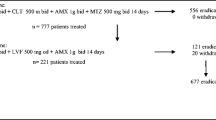Abstract
Background
Our aim was to assess, in obese patients undergoing Roux-en Y gastric bypass surgery, the cumulative Helicobacter pylori (HP) eradication rates in two consecutive time spans (2006–2008 and 2009–2010).
Methods
The study adopted a 14-day clarithromycin-based triple therapy in first-line treatment as proposed by the Maastricht III consensus—proton pump inhibitor bid, clarithromycin 500 mg bid and amoxicillin 1,000 mg bid—and a 14-day second-line levofloxacin-based empirical regimen—proton pump inhibitor bid, amoxicillin 1,000 mg bid and levofloxacin 500 mg od.
Results
In 2006–2008, 253 patients received first-line therapy. HP was eradicated in 200 patients and 14 patients withdrew (intention to treat (ITT) = 79.1 %; per protocol (PP) = 83.7 %). In the remaining 39 patients, HP was eradicated in 22 patients and 8 patients withdrew (ITT = 56.4 % and PP = 71.0 %). Thus, out of 253 patients, HP was eradicated in 222 patients, 22 patients withdrew and 9 remained positive. In 2009–2010, 437 patients received first-line therapy. HP was eradicated in 256 patients and 30 patients withdrew (ITT = 58.6 %; PP = 62.9 %). In the remaining 151 patients, HP was eradicated in 80 and 6 patients withdrew (ITT = 53.0 % and PP = 55.1 %). These results give cumulative eradication rates of 87.7 % ITT and 96.1 % PP (2006–2008) and of 76.9 % ITT and 83.8 % PP (2009–2010).
Conclusions
Cumulative HP eradication rates have fallen during 2006–2010 due to the fall of first-line eradication therapy rate, which was around 20 %. Therefore, the first-line clarithromycin-based Maastricht III consensus eradication is no longer effective in bariatric patients indicating the need to test new regimens.


Similar content being viewed by others
References
Quina M, Guerreiro A. Gastric cancer (carcinoma) and Helicobacter pylori: situation in Portugal. Hepato Gastroenterol. 2001;48:1565–8.
Ferlay J, Autier P, Boniol M, et al. Estimates of cancer incidence and mortality in Europe in 2006. Ann Oncol. 2007;18:581–92.
Cerqueira RM, Manso MC, Correia MR, et al. Helicobacter pylori eradication therapy in obese patients undergoing gastric by-pass surgery—fourteen days superior to seven days? Obes Surg. 2011;21(9):1377–81.
Fried M, Hainer V, Basdevant A, et al. European guidelines on surgery of severe obesity. Int J Obes. 2007;31:569–77.
ASGE Guidelines. Role of endoscopy in the bariatric patient. Gastrointest Endosc. 2008;68:1–10.
Malfertheiner P, Megraud F, O’Morain C, et al. Current concepts in the management of Helicobacter pylori infection. The Maastricht 2-2000 Consensus Report. Aliment Pharmacol Ther. 2002;16:167–80.
Malfertheiner P, Megraud F, O’Morain C, et al. Current concepts in the management of Helicobacter pylori infection. The Maastricht III Consensus Report. Gut. 2007;56:772–81.
Graham DY, Fischbach L. Helicobacter pylori treatment in the era of increasing antibiotic resistance. Gut. 2010;59:1143–53.
Malfertheiner P, Megraud F, O’Morain C, et al. Current European concepts in the management of Helicobacter pylori infection—the Maastricht I Consensus Report. The European Helicobacter Pylori Study Group (EHPSG). Eur J Gastroenterol Hepatol. 1997;9:1–2.
WHO. The global burden of disease. 2004 update (online), http://www.who.int/healthinfo/globalburdendisease/2004reportupdate/en/index/html (2008).
Mathers CD, Loncar D. Projections of global mortality and burden of disease from 2002 to 2030. PLoS Med. 2006;3:e 442.
Kearney DJ, Brousal A, et al. Treatment of Helicobacter pylori infection in clinical practice in the United States. Dig Dis Sci. 2000;45:265–71.
Saad RJ, Chey WD. Treatment of Helicobacter pylori infection in 2006. Gastroenterol Hepatol Ann Rev. 2006;1:30–5.
Kadayifci A, Buyukhatipoglu H, Cemil Savas M, et al. Eradication of Helicobacter pylori with triple therapy: an epidemiological analysis of trends in Turkey over 10 years. Clin Ther. 2006;28:1960–6.
Mégraud F. H. pylori antibiotic resistance: prevalence, importance and advances in testing. Gut. 2004;53:1374–84.
Sanchez JA, Saenz NG, Rincon MR, et al. Susceptibility of Helicobacter pylori to mupirocin, oxazolidinones, quinupristin/dalfopristin and new quinolones. J Antimicrob Chemother. 2000;46:283–5.
Antos D, Schneider-Brachert W, Bastlein E, et al. 7-day triple therapy of Helicobacter pylori infection with levofloxacin, amoxicillin and high dose esomeprazole in patients with known antimicrobial sensitivity. Helicobacter. 2006;11:39–45.
Yahav J, Shmuely H, Niv Y, et al. In vitro activity of levofloxacin against Helicobacter pylori isolates from patients after treatment failure. Diagn Microbiol Infect Dis. 2006;55:81–3.
Gisbert P, Morena F. Systematic review and meta-analysis: levofloxacin-based rescue regimens after Helicobacter pylori treatment failure. Aliment Pharmacol Ther. 2006;23(1):35–44.
Saad RJ, Schoenfeld P, Kim HM, et al. Levofloxacin based triple therapy versus bismuth based quadruple therapy for persistent Helicobacter pylori infection: a meta-analysis. Am J Gastroenterol. 2006;101:488–96.
Cabrita J, Oleastro M, Matos R. Features and trends in Helicobacter pylori antibiotic resistance in Lisbon area, Portugal (1990–1999). J Antimicrob Chemother. 2000;46:1029–31.
Gisbert JP, Calvet X. Review article: the effectiveness of standard triple therapy for Helicobacter pylori has not changed over the last decade but is not good enough. Aliment Pharmacol Ther. 2011;34:1255–68.
Gisbert JP, Gisbert JL, Marcos S, et al. Empirical rescue therapy after Helicobacter pylori treatment failure. A 10 year single center study of 500 patients. Aliment Pharmacol Ther. 2008;27:346–54.
Rokkas T, Sechopoulos P, Robotis I, et al. Cumulative H. pylori eradication rates in clinical practice by adopting first and second line regimens proposed by the Maastricht III consensus and a third line empirical regimen. Am J Gastroenterol. 2009;104:21–5.
Acknowledgments
The author M.C. Manso acknowledged Fundação para a Ciência e a Tecnologia through grant PEst-C/EQB/LA0006/2011.
Conflicts of Interest
None.
Author information
Authors and Affiliations
Corresponding author
Rights and permissions
About this article
Cite this article
Cerqueira, R.M., Correia, M.R., Fernandes, C.D. et al. Cumulative Helicobacter pylori Eradication Therapy in Obese Patients Undergoing Gastric Bypass Surgery. OBES SURG 23, 145–149 (2013). https://doi.org/10.1007/s11695-012-0747-4
Published:
Issue Date:
DOI: https://doi.org/10.1007/s11695-012-0747-4




